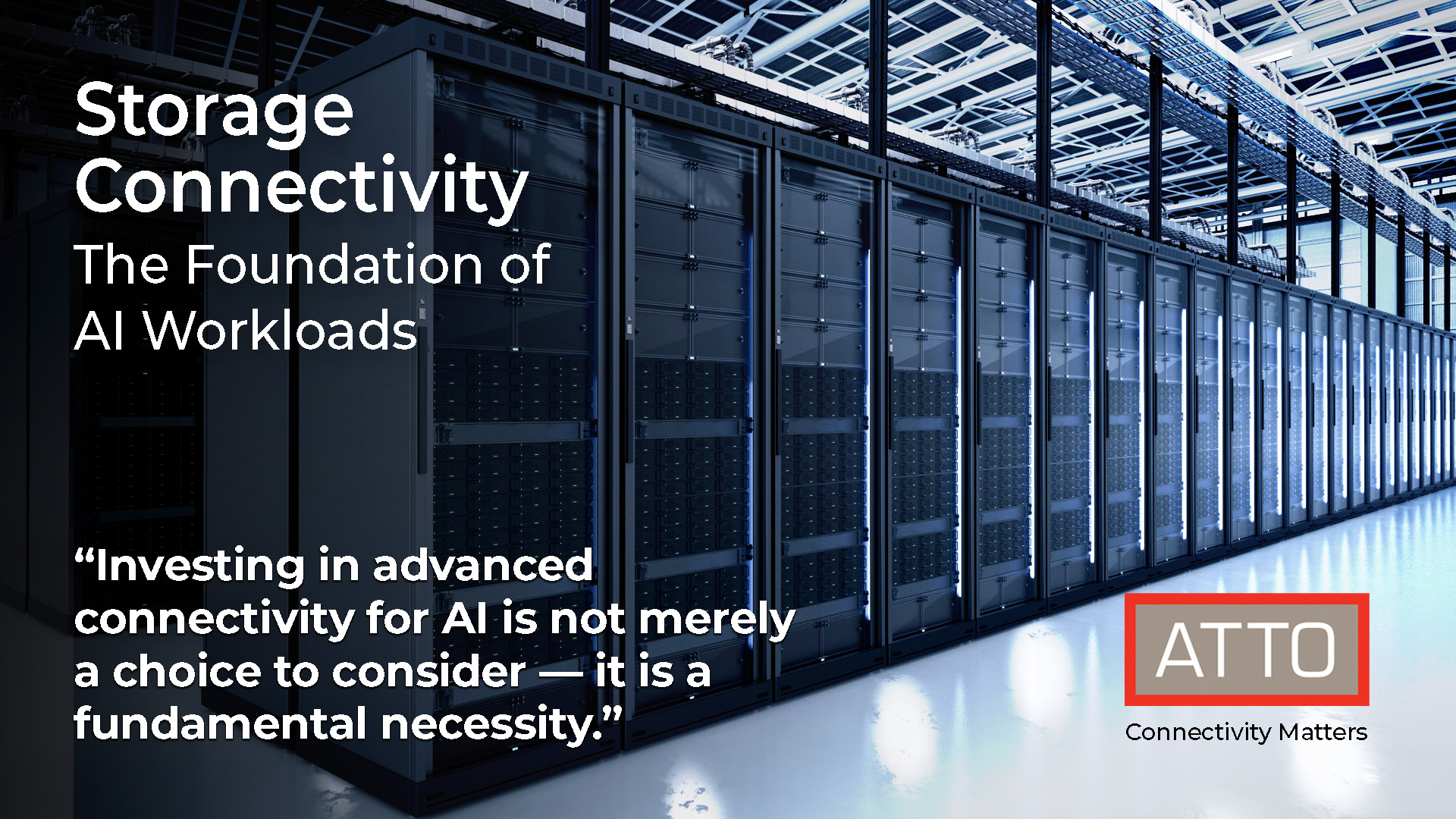
Storage Connectivity: The Foundation of AI Workloads
Imagine training an AI model that powers a sophisticated chatbot or predicts complex market trends. Now, picture that process stalling because the massive datasets it requires cannot reach the processors fast enough. This bottleneck is a critical challenge in the era of advanced artificial intelligence. AI workloads, which intensely process vast and often unpredictable datasets to create cutting-edge models, are fundamentally reliant on high-performance connectivity to ensure smooth and rapid data flow.
Not all connectivity is equipped to handle the unique demands of AI. In the context of AI, two primary types of connectivity are paramount: networking and storage connectivity. Networking facilitates shared data access by connecting servers to high-performance storage networks. Storage connectivity, particularly direct-attached storage (DAS), is crucial for feeding data directly to GPUs, the specialized processors that drive AI computation.
For those new to the intricacies of AI infrastructure, think of networking as the expansive highways that transport data from centralized storage hubs to various processing centers. In parallel, picture DAS as the dedicated, high-speed pipelines that deliver data directly and instantly to the GPUs. For seasoned AI professionals, the focus is keenly on maximizing bandwidth and minimizing latency—two critical factors for ensuring optimal GPU efficiency and utilization.
High-performance connectivity solutions are the key differentiator, enabling the massive data flows required for advanced AI training and inference. Understanding why these solutions, and the expert providers behind them, are essential is key to unlocking AI success.
Why AI Depends on High-Performance Connectivity
AI workloads are inherently data-hungry processes. Models, whether powering conversational agents or sophisticated recommendation systems, require colossal amounts of data to be moved with exceptional speed to GPUs. If the data delivery pipeline is slow or inefficient, GPUs can become idle, leading to wasted computational resources and significant delays. Industry studies highlight that even millisecond delays in data transfer can reduce GPU efficiency, impacting performance and increasing operational costs.
AI training relies on high-throughput connectivity to deliver massive datasets to GPUs, minimizing delays in iterative processing. Inference, however, demands ultra-low latency for real-time, smaller data transfers, often leveraging in-memory processing or rapid storage access to ensure responsiveness. Whether you are an innovative startup developing a new AI model or a large technology enterprise pushing the boundaries of AI capabilities, fast, reliable connectivity is not merely advantageous; it is a non-negotiable requirement for progress and competitiveness.
High-performance connectivity, encompassing both storage networks and DAS, ensures a seamless and continuous flow of data, keeping demanding AI workloads operating at peak performance. This is about more than just raw speed; it’s about delivering data with minimal delays (low latency) and maximum capacity (high bandwidth). These solutions are specifically engineered to handle the unpredictable and often unstructured nature of AI data—including images, text, sensor inputs, and more—without introducing performance bottlenecks. Partnering with expert connectivity providers ensures these solutions are optimized for AI’s unique demands, delivering scalability and reliability. Let’s explore the distinct yet complementary roles that networking and storage connectivity play in powering the next generation of AI.
Networking for AI Servers: The Data Highways
Networking in AI is fundamental for connecting servers to high-performance storage networks, enabling rapid access to massive datasets required for training and inference. In large-scale AI training environments, servers must efficiently retrieve unstructured data, such as vast libraries of images or extensive text corpuses, from centralized storage systems like a storage area network (SAN) or network attached storage (NAS) to feed the AI models being processed. Without fast and reliable networking, data delivery becomes a significant bottleneck, directly stalling the training process and hindering progress.
Modern high-performance networking solutions are capable of delivering bandwidths up to 400 gigabits per second (Gbps) with impressively minimal latency. This enables seamless and rapid access to centralized storage networks, which is critical for distributed AI training where multiple servers work in parallel on different segments of a dataset. For example, hyperscale providers rely on such high-speed networking to support efficient data access for large GPU clusters training models like those used in natural language processing.
Key benefits of high-performance networking for AI include:
- Faster Data Access: High-bandwidth links to storage networks significantly accelerate dataset retrieval times.
- Improved Efficiency: Low-latency networking ensures that GPUs remain continuously supplied with data, directly enhancing training speed and throughput.
- Scalability: High-performance networking provides the necessary foundation to support growing storage demands and expanding AI projects without creating bottlenecks.
For AI development teams, this translates to streamlined data pipelines and the ability to scale increasingly ambitious projects with confidence, free from connectivity limitations.
Storage Connectivity for AI Data: The Direct Pipelines
While networking provides the vital links connecting servers to storage networks, direct-attached storage (DAS) connectivity serves a critical, more immediate role: feeding data directly to the GPUs that power AI. For AI to function effectively, these powerful processors require incredibly rapid access to massive datasets—think vast collections of images, extensive text documents, or large video files. Any delay in data delivery can lead to GPUs sitting idle, a significant inefficiency that slows down the entire training or processing pipeline.
In the early 2010s, SAS and SATA interfaces supported early AI applications by providing reliable data access. Since about 2014, NVMe (Non-Volatile Memory Express) has become the standard for AI workloads, delivering the ultra-low latency and high bandwidth essential for feeding massive datasets to GPUs, ensuring peak performance. NVMe connects directly to the server’s PCIe bus, dramatically reducing the time it takes for data to travel from storage to the GPU.
Advanced GPU-direct technologies, such as ATTO’s Direct2GPU and similar solutions, further optimize AI performance by enabling direct data transfers from storage to GPU memory. By bypassing CPU overhead, these innovations reduce latency and maximize throughput, ensuring GPUs remain fully utilized for data-intensive AI workloads. Partnering with expert connectivity providers enhances the reliability and scalability of such solutions.
Think of the difference between traditional interfaces and modern solutions like NVMe and GPU-direct technologies as different delivery routes. SAS/SATA provided efficient multi-lane roads for data, capable of handling substantial traffic. NVMe and GPU-direct solutions, on the other hand, are like dedicated, high-speed express routes built for the fastest vehicles, allowing data to arrive with unprecedented speed and minimal delay. This performance boost is crucial for preventing GPU “starvation” and ensuring these expensive compute resources are utilized to their fullest potential.
Key advantages of high-performance direct-attached storage, including NVMe and GPU-direct technologies, for AI include:
- Maximized GPU Efficiency: Swift and direct access to data keeps GPUs actively processing, significantly reducing costly idle periods.
- Faster Results: Accelerating the data pipeline directly contributes to quicker training cycles and faster time to deploy AI models.
- Enhanced Flexibility: These high-performance connections efficiently handle the diverse types of unstructured data critical for training modern, complex AI models, from simple text to high-resolution multimedia.
This direct, high-performance connection is like a continuous, precision-controlled high-octane fuel line, ensuring that GPUs have the resources they need, precisely when they need them, to power through the most demanding AI training and processing tasks.
Investing in AI’s Future: A Strategic Imperative
Investing in high-performance connectivity is not solely about achieving peak performance in the present; it is a strategic imperative for building value and ensuring long-term success in AI development and deployment. High-quality storage networking and DAS solutions, such as those leveraging NVMe and GPU-direct technologies, are engineered for durability and scalability, designed to seamlessly support AI workloads as they grow in size and complexity. By optimizing data flow and minimizing inefficiencies, these solutions also contribute to reduced operational costs.
Leading organizations recognize the significant payoff of partnering with expert connectivity providers. These partnerships translate into faster training times, more efficient utilization of expensive GPU resources, and the ability to push the boundaries of what is possible with AI. Whether your focus is on training a specialized small model or scaling a global AI platform, these advanced connectivity solutions provide the essential foundation for achieving your goals and maintaining a competitive edge.
The Path to AI Innovation
High-performance connectivity is undeniably the backbone of modern AI. By delivering fast storage networking and direct, high-speed storage access through solutions like NVMe and GPU-direct technologies, it provides the critical infrastructure needed to power cutting-edge AI models and drive innovation. As AI workloads continue their exponential growth, fueled by ongoing advancements and ambitious projects, partnering with expert connectivity providers is paramount for ensuring efficiency, enabling scalability, and maintaining competitiveness in the rapidly evolving AI landscape. For businesses determined to lead in the age of artificial intelligence, investing in advanced connectivity is not merely a choice to consider—it is a fundamental necessity to build the future.
ATTO Technology High-Performance Connectivity Solutions for AI
ExpressNVM Smart NVMe Switch Adapters
